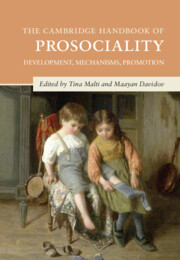Book contents
- The Cambridge Handbook of Prosociality
- Cambridge Handbooks in Psychology
- The Cambridge Handbook of Prosociality
- Copyright page
- Dedication
- Contents
- Figures
- Contributors
- Part I Development of Prosociality
- Part II Antecedents and Mechanisms of Prosociality
- Part III Development of Prosociality in Context
- 18 Parenting and Children’s Prosociality
- 19 Sibling Influences on Prosociality
- 20 Prosocial Behavior, Peer Relationships, and Friendships
- 21 Children’s Intergroup Prosocial Behavior
- 22 Prosocial Behavior in School Contexts
- 23 Community and Neighborhood Influences on Prosociality in Children and Youth
- 24 Culture and Prosociality
- 25 Prosocial Media
- Part IV Applications
- Index
- References
19 - Sibling Influences on Prosociality
From Infancy to Adolescence
from Part III - Development of Prosociality in Context
Published online by Cambridge University Press: 25 May 2023
- The Cambridge Handbook of Prosociality
- Cambridge Handbooks in Psychology
- The Cambridge Handbook of Prosociality
- Copyright page
- Dedication
- Contents
- Figures
- Contributors
- Part I Development of Prosociality
- Part II Antecedents and Mechanisms of Prosociality
- Part III Development of Prosociality in Context
- 18 Parenting and Children’s Prosociality
- 19 Sibling Influences on Prosociality
- 20 Prosocial Behavior, Peer Relationships, and Friendships
- 21 Children’s Intergroup Prosocial Behavior
- 22 Prosocial Behavior in School Contexts
- 23 Community and Neighborhood Influences on Prosociality in Children and Youth
- 24 Culture and Prosociality
- 25 Prosocial Media
- Part IV Applications
- Index
- References
Summary
Siblings are often overlooked as a source of social influence. Addressing this gap, we review findings from studies spanning the transition to siblinghood through adolescence. We have identified four features of sibling relationships that help explain siblings’ powerful influence on children’s prosocial behavior: sibling relationships are (1) emotionally unfettered; (2) diagonal, especially in the early years; (3) familiar; and (4) long-lasting. Research is framed by several distinct theoretical perspectives, including attachment theory, ethology, family systems theory, and cognitive accounts of theory of mind development. Sibling influences also take many forms that vary in salience across the different aspects of prosocial behavior and distinct developmental periods. Over time, sibling influences show both stability and change, but appear independent from parental influences – although evidence is scarce for some groups. Finally, we discuss future directions, as well as conclusions regarding the nature, motivation, and impact of sibling influences on prosocial behavior.
Keywords
- Type
- Chapter
- Information
- The Cambridge Handbook of ProsocialityDevelopment, Mechanisms, Promotion, pp. 388 - 408Publisher: Cambridge University PressPrint publication year: 2023



